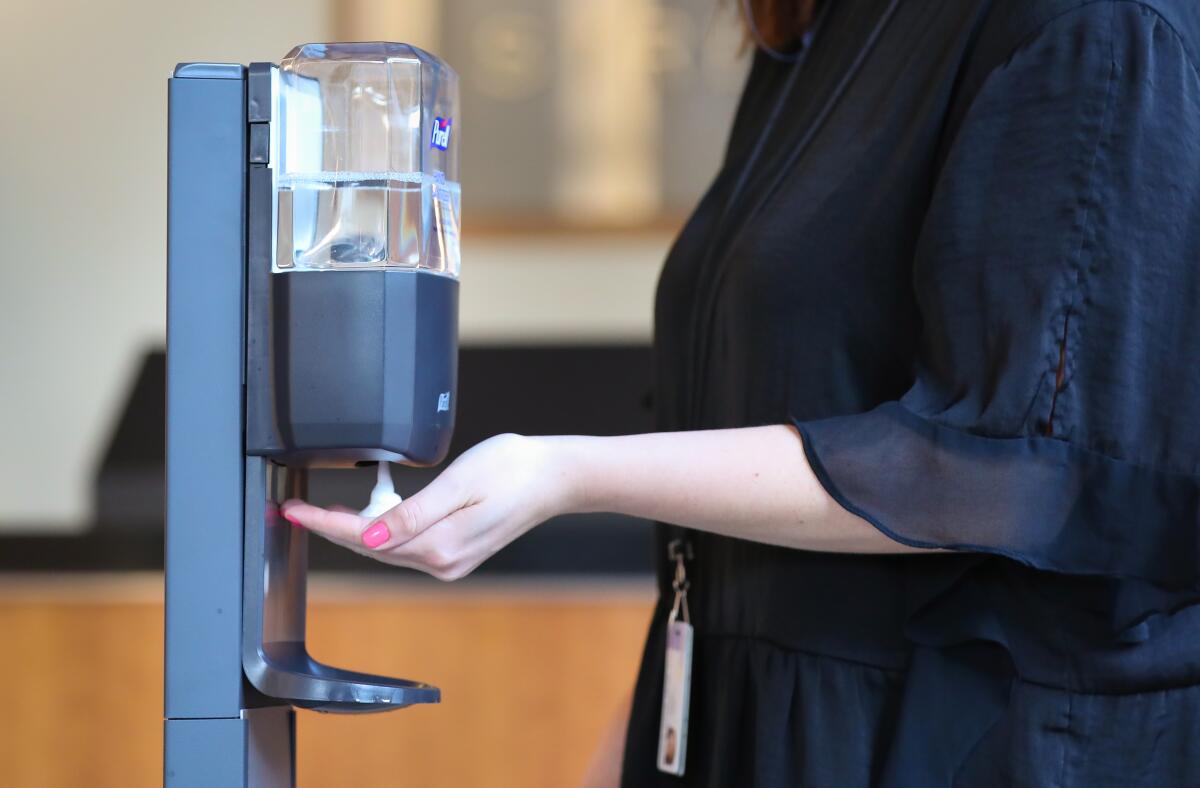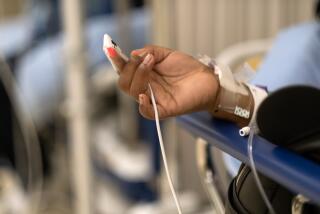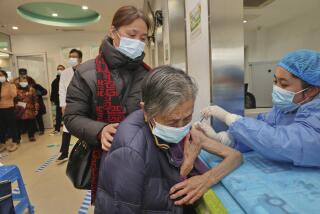How does coronavirus spread? How do you get it?

- Share via
Growing concerns about the coronavirus pandemic in the last 24 hours — with California calling for a ban on many public events, the NBA suspending its season, a ban on travel from Europe and actor Tom Hanks announcing that he and his wife are ill — have raised some basic questions about the infection.
What are the symptoms?
Here’s a closer look at the symptoms associated with the coronavirus that’s causing the current outbreak. Keep in mind that many of these symptoms also can be caused by more common kinds of infections, including something as mundane as the common cold.
Fever
The body temperature of a healthy person averages 98.6 degrees Fahrenheit (or 37 degrees Celsius). Some people tend to run a little higher or a little lower, but if you hit 100.4 degrees F (or 38 degrees C), you have a fever.
Sometimes a fever makes you feel hot and sweaty. Other times it gives you chills, so that you’ll shiver and generate more body heat. Aches, weakness and loss of appetite may also occur.
A fever is usually a sign that your body is fighting off some kind of infection. The higher internal temperature makes it more difficult for disease-causing viruses and bacteria to survive.
A fever also prompts your immune system to swing into action. The elevated temperature triggers the body to switch on genes that regulate the body’s inflammatory response. When inflammation occurs, affected tissues attract immune system cells called phagocytes that ingest and neutralize invading pathogens.
Though infections are the most common cause of fevers, they aren’t the only ones. A fever can be a side effect of certain medications and vaccines. It can also be a side effect of some autoimmune diseases, such as rheumatoid arthritis and certain types of cancer.
In general, adults need not be concerned about a fever unless their temperature hits 103 degrees Fahrenheit, according to the Mayo Clinic. Any fever in an infant or toddler, however, should be taken seriously.
Cough
Like a fever, a cough is a way for the body to get rid of pathogens that make us sick.
Sometimes coughs are voluntary; other times, they happen automatically. Either way, a successful cough will expel viruses, bacteria and other foreign invaders from the respiratory tract before they reach the lungs, where they can cause more serious problems.
Some coughing is normal, but if a cough lasts for weeks, it may be time to see a doctor, the Mayo Clinic advises. The same goes for a cough that brings up mucus that contains blood or that is thicker or darker than usual. Some coughs are so severe that they can induce headaches, dizziness, urinary incontinence and the urge to throw up.
How forceful can a cough get? According to experts at Harvard Medical School, air can shoot out from your lungs and through your air passages at a velocity that approaches the speed of sound.
Shortness of breath
A variety of lung conditions can cause shortness of breath, including pneumonia, asthma and chronic obstructive pulmonary disease. So can cardiovascular problems, such as a heart attack, low blood pressure, abnormal heartbeats or heart failure.
The heart and lungs are responsible for delivering oxygen to organs and tissues throughout the body and removing the carbon dioxide that’s a byproduct of respiration. If this isn’t happening and the amount of CO2 in the blood gets too high, the brain instructs the body to breathe more often or more deeply. That may make you feel short of breath, the American Lung Assn. explains.
A person experiencing shortness of breath — the medical term is “dyspnea” — can feel winded doing something as simple as walking, taking the stairs or even sitting still, according to the Chest Foundation.
The best way to treat dyspnea depends on the cause, which can vary from person to person. If a blood clot is to blame, a prescription for blood-thinning medications may be in order. If it’s asthma, a bronchodilator could be the best way to open up the airways.
Pneumonia
In the early days of the outbreak, coronavirus patients in China were believed to be sick with pneumonia. The World Health Organization now says pneumonia can be a symptom of a serious case of coronavirus infection.
An infection in one or both lungs can result in pneumonia. A virus can trigger the disease. So can bacteria, fungi or other types of germs.
Certain groups of people are more vulnerable than others, according to the National Heart, Lung and Blood Institute. For instance, those who already have an underlying health problem are more susceptible to pneumonia. So are children under the age of 5 and seniors who are at least 65. Severe cases require hospitalization — indeed, pneumonia is the No. 1 cause of hospitalizations in the U.S. — but many people can recover at home with the help of antibiotics or other medications.
Kidney failure
Severe cases of coronavirus infection may result in kidney failure, the WHO says. A patient is considered to have kidney failure when at least 85% of his or her kidney function is gone, according to the National Kidney Foundation.
The kidneys are responsible for cleaning the blood, removing waste products and acids as well as extra fluid. Without proper kidney function, your blood can’t maintain the necessary balance of water, salts and minerals to keep muscles, nerves and other tissues working as they should, says the National Institute of Diabetes and Digestive and Kidney Diseases.
The kidneys, each about the size of a fist, also produce hormones that make red blood cells, keep blood pressure in check and maintain bone health.
When the kidneys can’t filter blood on their own, patients must turn to dialysis treatment to pick up the slack. With hemodialysis, the blood is removed from the body and cleaned in a dialyzer, or artificial kidney, before being returned. With peritoneal dialysis, the lining of the abdomen (called the peritoneum) does this job with the help of a dialysis solution delivered through a catheter.
A more permanent solution for kidney failure is a transplant from a matched donor. Only one healthy kidney is needed for a transplant to be a success.
How does this coronavirus differ from previous viruses?
Two other coronaviruses have fueled outbreaks in the 21st century. This coronavirus is different.
SARS — short for severe acute respiratory syndrome — originated in China’s Guangdong province in 2002 and spread to 29 countries. By the time it was contained in 2003, it had caused 8,096 illnesses and 774 deaths.
MERS — or Middle East respiratory syndrome — began in 2012 and sickened at least 2,494 people in 27 countries. At least 858 people died in that outbreak.
The new coronavirus is different from SARS and MERS in two respects.
First, it spreads more easily in public. In less than three months, it has reached more than 60 countries and territories.
Second, it’s less deadly. In a comprehensive study of 44,672 confirmed coronavirus cases in mainland China, 1,023 people died, researchers from the Chinese Center for Disease Control and Prevention reported in the Journal of the American Medical Assn. That results in a case-fatality rate of 2.3%, the study said.
The death rate due to SARS was about 9.6%, and the fatality rate for MERS is 34.4%.
The actual fatality rate for the new coronavirus may be quite a bit lower than 2.3% because people who are infected but experience only mild illness — or no symptoms at all — are massively undercounted, experts said. The true death rate could be as low as 0.2%, said Dr. Otto Yang, an infectious disease expert at UCLA.
There are four other coronaviruses that produce symptoms no worse than a common cold in most people who do not have severely weakened immune systems, Yang said. These viruses are responsible for 20% to 30% of common colds around the country every year, he said.
There continue to be concerns that visibly healthy people can shed the new coronavirus, which would make the virus more easily transmittable throughout the community.
How is coronavirus spread?
- The virus is thought to spread mainly through person-to-person contact.
- Between people who are in close contact with one another (within about 6 feet).
- Through respiratory droplets produced when an infected person coughs or sneezes.
- These droplets can land in the mouths or noses of people who are nearby or possibly be inhaled into the lungs.
Source: Centers for Disease Control and Prevention
Simple steps to protect yourself
- Avoid touching eyes, nose or mouth with unwashed hands.
- Cover your cough or sneeze with a tissue or your elbow.
- Avoid close contact with people who are sick.
- Stay away from work, school or other people if you become sick with respiratory symptoms such as fever and cough.
- Follow guidance from public health officials.
- Wash hands with soap and water.
Source: State of California
Times staff writers Karen Kaplan, Melissa Healy and Rong-Gong Lin II contributed to this report.
More to Read
Sign up for Essential California
The most important California stories and recommendations in your inbox every morning.
You may occasionally receive promotional content from the Los Angeles Times.










